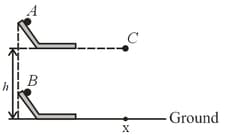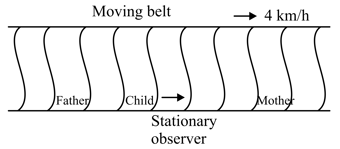What is point mass give examples?
Important Questions on Motion and Measurement of Distance
Three balls, and are released and all reach the point (shown in the figure). Balls and are released from two identical structures, one kept on the ground and the other at height from the ground as shown in the figure. They take time and respectively to reach (time starts after they leave the end of the horizontal portion of the structure). The ball is released from a point at height vertically above and reaches in time . Choose the correct statement.

When a particle moves with variable velocity, which of the following statement are NOT correct ?
(i) Average speed = average velocity
(ii) Instantaneous speed = instantaneous velocity
(iii) Distance covered = magnitude of displacement
Two skaters, and are skating towards each other. Skater, throws a ball towards, every such that it always leaves her hand with speed with respect to the ground. Consider two cases: (I) runs with speed towards while remains stationary. (II) runs with speed towards while remains stationary. Note That irrespective of speed of ball always leaves s hand with speed with respect to the ground. Ignore gravity. Balls will be received by
A child runs to and fro with a speed (with respect to the belt) on a long horizontally moving belt (figure) between is father and mother located apart on the moving belt. The belt moves with a speed of . For an observer on the stationary platform outside, what is the speed of the child running in the direction of motion of the belt and speed of the child running opposite to the direction of motion of the belt? time taken by the child in and . Which of the answers will alter if motion is viewed by one of the parents?

Which of the following statements are correct?

